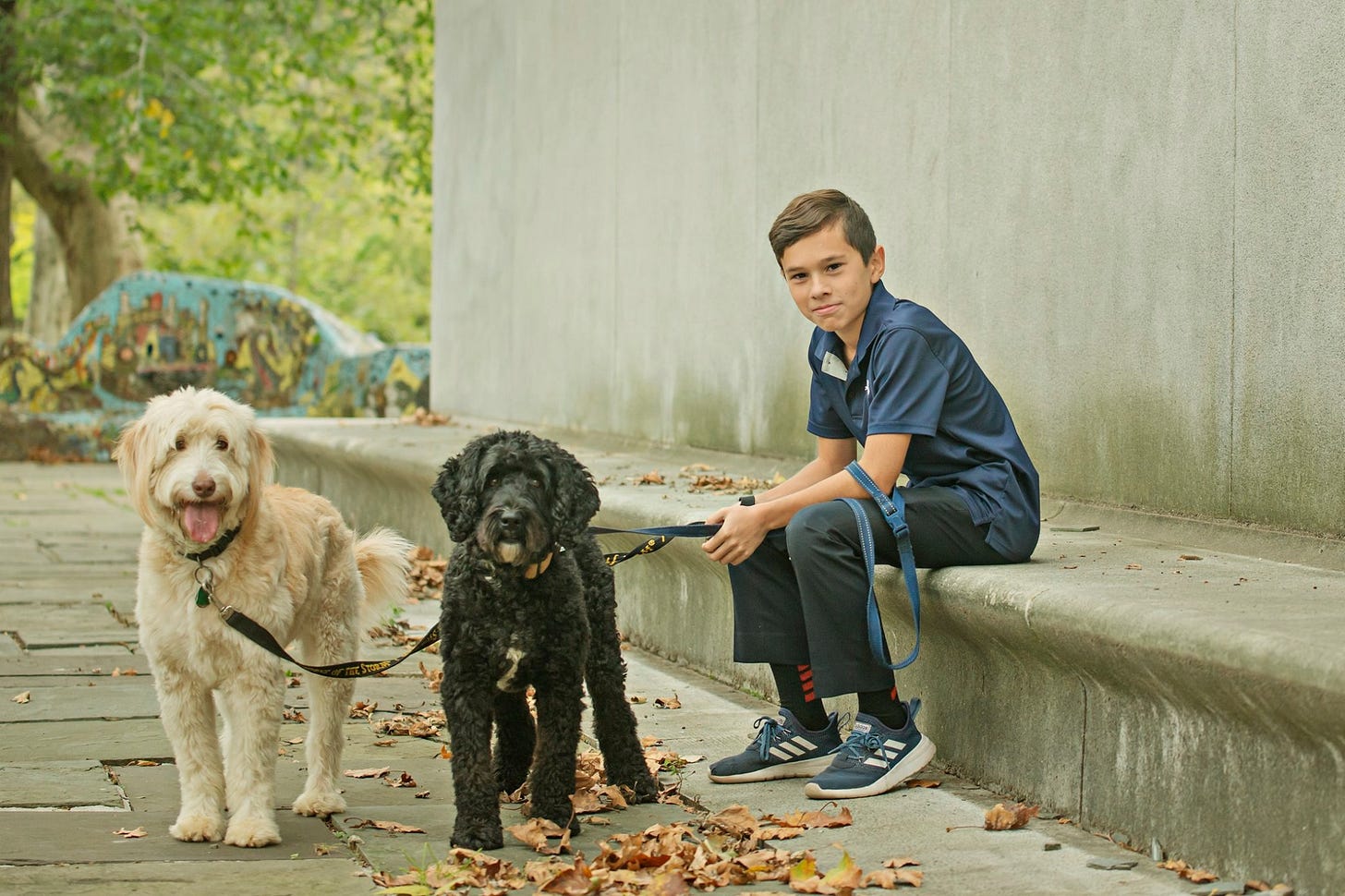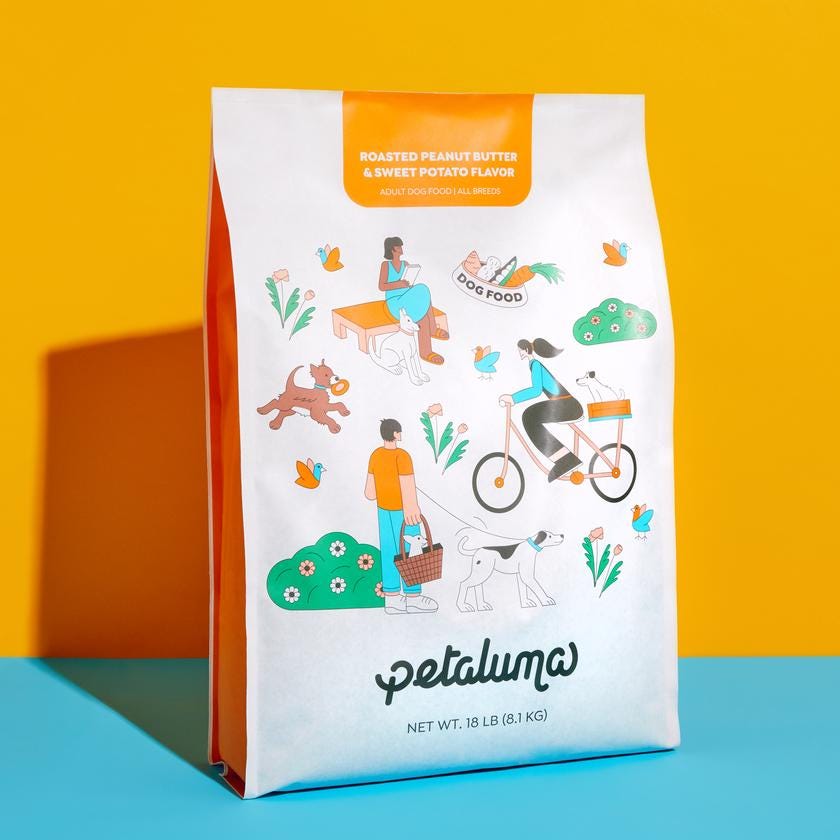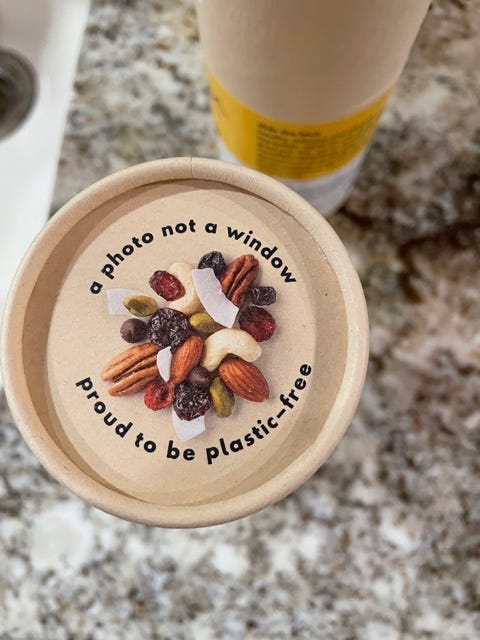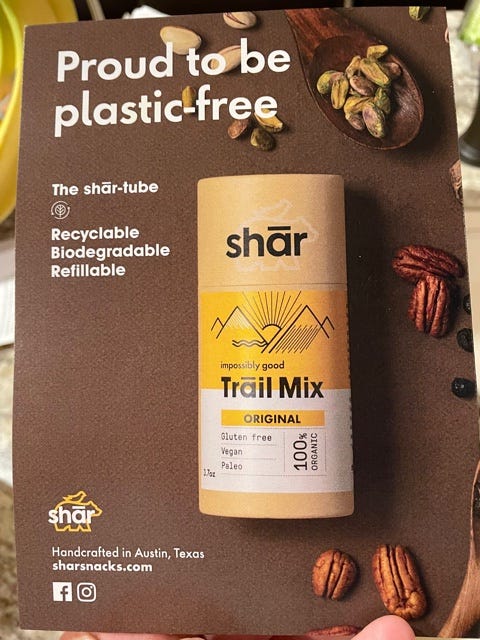The title says “Pets”, but I’m a dog person. My sweet dog Sadie is at my feet as I type.
Dogs eat food. So we need to eliminate the carbon emissions of dog food. I hope cat food emissions are also eliminated, but I’d be ok if we just eliminate the cats. 🤪

U.S. dogs consume > 32 billion pounds of protein per year, and much of it is industrial meat. UCLA professor Gregory Okin: “U.S. cats and dogs cause 25-30 percent of the environmental impact of meat consumption in this country. The nation's 163 million cats and dogs eat as much food as all the people in France.” This is a big opportunity!
Let’s shine the spotlight on Petaluma, the (brand new!) plant-based dog food startup. Caroline Buck, Petaluma’s Co-Founder & CMO, told me on Wednesday that consumers will pay a premium for carbon neutral pet food, but that premium is limited because people are more price sensitive for dog food than human food. Sourcing all plant-based ingredients helps her eliminate 70%-80% of the carbon footprint of Petaluma compared to traditional dog foods. And she’s confident dogs, which are omnivores like us, can thrive on plant-based diets.
Petaluma operates with zero net carbon emissions. They limit emissions associated with growing, manufacturing, and shipping products, and then purchase carbon credits to offset remaining emissions. They helpfully published a dog food LCA.
How do we get to 100% Carbon Negative pet food? I was amazed at the variety of strategies and companies - big and small- working on these problems.
Plant-Based. Petaluma , as described above, reduces its carbon footprint with thoughtful plant-based ingredients (including dried yeast). This is a strategy many readers use to reduce their own emissions.
Fungal Yeast. Like Petaluma, Wild Earth argues that there are several sufficient sources of protein for dogs. Wild Earth relies on fungal yeast, which they state is neither plant nor animal.🤔
Insects. Jiminy’s uses grubs and crickets. Mars and Nestle are sourcing black soldier flies. See Yora’s clever video describing how they grow insect grubs in clean recycled vegetable waste. Insect-based dog food is not crazy, as we are also seeing insect protein make its way into human food. I may give this a go for my dogs.
Invasive Species. While researching the kelp edition of this newsletter, I learned about the invasive green crabs infesting the waters around Portland Maine. So I was fascinated to learn that Rootlab, a Purina brand, makes dog food with invasive species such as Asian Carp and Green Crabs (as well as insects). Casey, is this the green crabs solution?
Cultured Meat. Bond Pet Foods uses a scientific process (similar to how beer and cheese are made) to create cultured chicken protein. Because Animals is trying to create cultured mouse protein food for cats.
Multiple Alternative Sources. Chippin didn’t fit in any of the categories above, because they source dog food ingredients from plants (spirulina), insects (crickets) and invasive fish (wild-caught silver carp, to improve & protect the Great Lakes).
Upcycled. Shameless (like Do Good Chicken for humans) turns food waste into pet snacks!
Regenerative Agriculture. ethically raised is sourcing meat for dog food from regenerative farms. This is, obviously, similar to what’s being done for human beef.
Wow. So much. Not all of the brands above are carbon neutral or negative, but all of them are levers to push the pet food industry closer to zero emissions. As pet owning consumers, we should do everything we can to support this movement. Remember, dogs are people too, and they want to be helpful!
I used to be thoughtful about my family’s food while ignorant about my dogs’ food. Writing this edition was a wake up call. I’m inspired. This week I placed my first order with Petaluma! I’ll let you know what Carli & Sadie think.
Product Review: Shār Trail Mix
Shār (pronounced like bear) is based in Austin. You can buy their products at REI stores. Shār has achieved climate neutral certification with their delicious and healthy trail mixes, which are gluten free, vegan and paleo, and made from whole food organic ingredients responsibly sourced from small family farms.
Shār has gone next level with their packaging game. There is NO PLASTIC at all, and the design is beautiful. Check it out!
Your Feedback:
Sterling Crew sent a link to his paper on food waste
My old college friend Bryant responded to the Food Waste edition: “is that $400B food waste number truly vetted? If so, that’s astounding to me. If we have 330M people in the country, that’s $1,212/person or $100/month for every man, woman and child in the entire country. I know that my family is not 100% efficient in that regard, and I know that there are many other factors besides individual consumption, but that is truly awful if the number is that high.”
A business person from the other side of the world sent a note that included: “You are curating a fantastic resource for myself and very many others trying to make sense of the world and what can be done with purpose." Thank you!
What’s your feedback on this edition of the newsletter? Let me know!
For Your Further Consideration:
Mark Lewis, hunting for unicorns in regenerative agriculture and food [Investing in Regenerative Agriculture podcast]
The Food System’s Carbon Footprint Has Been Vastly Underestimated
To make agriculture more climate-friendly, carbon farming needs clear rules
‘Cows are the new coal’: Investors urge governments to reduce agricultural emissions
A harvest for the world: A Black family farm is fighting racism in agriculture and climate change
How This Tech Uses Fungi To Help Farmers Tackle Climate Change
Senate passes first-ever climate mitigation bill for agriculture
Why New England is going wild for wet weeds [seaweed]
Nocarbon [carbon neutral milk in Brazil]
These farming techniques can help trap carbon dioxide in the soil and make farmers an extra buck
Witness the Many Forms of Food Waste Innovation
The views in this newsletter belong solely to Paul Lightfoot (and not to BrightFarms or other organizations). This newsletter accepts no advertising. Learn more about this newsletter at https://paullightfoot.substack.com/about.







For some further insight and expertise on this significant opportunity to improve pet sustainability check out this recent webinar from the American Sustainable Business Council and Pet Sustainability Coalition: https://vimeo.com/548546152